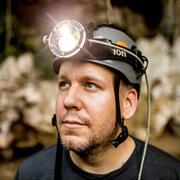What the world’s oldest cave paintings tell us about our human ancestors
As the home of the Australian Research Centre for Human Evolution, Griffith University unites world-leading archaeologists studying human evolution to progress understanding and knowledge of the human experience in Australia and South East Asia, but also covering Africa and other places around the globe.
Griffith’s highly regarded research in archaeology includes work covering archaeological excavation, dating techniques, analysis of lithic and organic technologies and, in particular, rock art.
Rock art consists of paintings, drawings, stencils, prints, petroglyphs, sculptures and figures made with beeswax found in caves and rock shelters, and on rock platforms and boulders. These are special, often spectacular places that reflect ancient experience, identity, history, spirituality and relationships to land. Critically, rock art is fixed in place. Griffith’s leading rock art specialist, Professor Paul Taçon, has not only made important rock art discoveries around the world but has also changed how rock art is interpreted, promoted and conserved, based on the tremendous significance of rock art for Indigenous peoples.
At Griffith, archaeology and the study of rock art integrate into larger studies of modern human behaviour. Rock art—an archive of deep-time human experience—is studied in combination with genetic, fossil and other archaeological evidence, allowing researchers to detail the journey from archaic to modern human, as well as explore the emergence of the modern human mind.
One of the most recent discoveries is what may be the world’s oldest known cave painting, found in Sulawesi, Indonesia, and dating to at least 45,500 years ago. Griffith Professors Maxime Aubert and Adam Brumm were part of a large international team who uncovered the cave painting, consisting of a figurative depiction of a Sulawesi warty pig – a wild boar endemic to South Sulawesi.
The Sulawesi warty pig painting found in the limestone cave of Leang Tedongnge is likely the earliest known work of art in the world. Professor Aubert used uranium-series analysis of the calcium carbonate deposits that form naturally on the cave wall surface used as a ‘canvas’ for the art. Using the same technique, Professor Aubert and the team discovered the previously oldest dated rock art ‘scene’ (at least 43,900 years old) at a nearby limestone cave site. The discovery and dating of a depiction of hybrid human-animal beings hunting Sulawesi warty pigs and dwarf bovids was ranked by the journal Science as one of the top 10 scientific breakthroughs of 2020.
The dated rock art of Sulawesi now represents the earliest archaeological evidence for modern humans in the oceanic islands known as Wallacea, located between Asia and Australia–New Guinea. Human ancestors must have crossed through Wallacea by watercraft to reach Australia by at least 65,000 years ago; however, the Wallacean islands are poorly explored, and the earliest excavated archaeological evidence from this region is much younger in age.
Regardless, according to Professors Aubert and Brumm, these discoveries underline the remarkable antiquity of Indonesia’s rock art and its great significance for understanding the deep-time history of art and its role in humanity’s early story.

